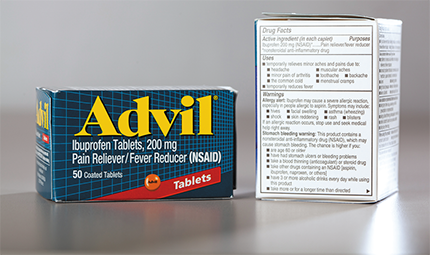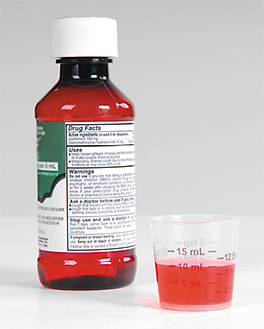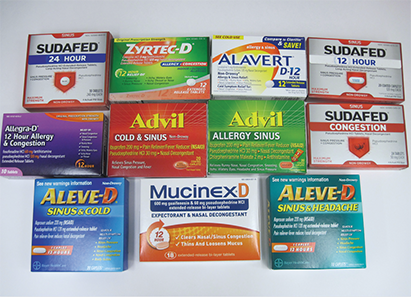9.1 Nonprescription Retail Sales
The front retail space of community pharmacies offers not only many brand name and generic OTC drugs but also complementary and alternative holistic health treatments for patients. These alternative remedies include homeopathic products, vitamins, minerals, herbs, and dietary supplements. They are arranged on shelves to let customers choose what they want from a variety of package sizes and formulations. Also displayed are other health and medical supplies and non-healthcare products such as cosmetics and toiletries, candy, snacks, drinks, gifts and gift cards, and impulse merchandise.

OTC medications are generally stocked according to their medical purpose such as pain relief, antacids, and so on.
Customer service remains paramount to the success of a community pharmacy. As a pharmacy technician, you will play a major role in assisting customers in locating the retail products they are seeking and processing their payments.
Over-the-Counter Drugs
Customers are purchasing OTC drugs for self-administration at an ever-increasing rate because of the increased cost and inconvenience of physician visits, the rising cost of prescription medications, the lack of adequate health insurance, and the high drug insurance deductibles. This self-medication practice, however, requires paying close attention to the product labeling, which not all customers do.
OTC drugs have been determined to be generally recognized by the Food and Drug Administration (FDA) as safe and effective for the approved indication when taken according to label directions. OTC drugs are usually arranged in the store by drug class or by indication, such as pain relievers, fever reducers, allergy medicine, contraceptive products (condoms, jellies), first-aid care, antacids, laxatives, foot-care products, and so on.
 Pharm Fact
Pharm Fact
Displaying nonprescription products on shelves for customers to locate for themselves was popularized by Walgreens in 1960, with other retailers following shortly thereafter.
Commonly requested OTC drugs are listed in Table 9.1. Many popular OTC drugs, such as hydrocortisone and ibuprofen, once required a prescription. The active ingredients are the same as those found in the higher-strength prescription formulations but are simply present in lower strengths and dosages. For example, OTC ibuprofen is available in a strength of 200 mg, whereas the prescription strengths are 400 mg, 600 mg, and 800 mg.
Pharmacy technicians should also be aware that a few significant OTC drugs are located in the refrigerated area of the pharmacy—in particular, fast-acting regular insulins such as Novolin and Humulin. These insulins can be sold to a patient with or without a prescription. Requests for nonprescription insulin often occur when a patient is traveling and needs more insulin. Longer-acting insulins (e.g., Lantus, Levemir) or mixtures of immediate and extended-action insulins (Humulin 70/30, Novolin 70/30) always require a prescription.
 Safety Alert
Safety Alert
Taking more than one OTC medication at once, such as cold and pain medications, can be dangerous. Teenagers particularly tend to self-medicate and mix medicines. Technicians can help all patients read labels and check ingredients. Acetaminophen products should not be taken with other OTC or prescription drugs containing acetaminophen.
Table 9.1 Common OTC Drugs and Their Indications
Generic Name |
Brand Name |
Indication(s) |
|---|---|---|
ibuprofen |
Advil/Motrin |
Headache, pain |
oxymetazoline |
Afrin |
Nasal decongestant |
naproxen |
Aleve |
Headache, pain |
fexofenadine |
Allegra |
Allergy |
diphenhydramine |
Benadryl |
Allergy |
loratadine |
Claritin |
Allergy |
hydrocortisone |
Cortizone-10 |
Itching, inflammation |
esomeprazole |
Nexium |
Heartburn |
famotidine |
Pepcid |
Heartburn |
fluticasone |
Flonase |
Allergy |
loperamide |
Imodium |
Diarrhea, irritable bowel syndrome |
clotrimazole |
Lotrimin |
Topical antifungal |
miconazole |
Monistat |
Vaginal antifungal |
guaifenesin |
Mucinex |
Expectorant |
triple antibiotic |
Neosporin |
Topical anti-infective |
lansoprazole |
Prevacid |
Heartburn |
omeprazole |
Prilosec |
Heartburn |
triamcinolone |
Nasacort |
Allergy |
cetirizine |
Zyrtec |
Allergy |
Role of the Pharmacist
Customers often seek counsel to help them select the appropriate OTC product for a special condition. Consider a mother asking for a cough syrup for her diabetic son; a pregnant woman on prenatal vitamin and iron supplements seeking the right laxative; or an elderly man with high blood pressure looking for an appropriate nasal decongestant. These patients would have medical difficulties if they took the usual OTC medications, so you need to direct them to a pharmacist’s counsel. Pharmacists are the only ones who can legally address questions about the right medication for a medical purpose or indication, the right dosage and administration, expected therapeutic effects, side effects, contraindications, and interactions—even for OTC vitamins.
Role of the Pharmacy Technician
You, however, can and should help customers find the brands and types of medications they are looking for. Who knows the store better than the person who has been stocking the shelves and putting the products in their places?
Technicians should also help customers understand the OTC product labels, which include the following:
product name and therapeutic purpose
directions for dosage and frequency of administration for different age groups
active and inactive ingredients (such as dyes)
any precautions or warnings
any special storage requirements and expiration date
 Practice Tip
Practice Tip
Be sure to remind customers that most OTC drugs should typically be used for only seven days or less.
Technicians are trained to understand this information and can go over labels with customers. Also, point out that manufacturers typically provide a toll-free number in case consumers have additional questions or concerns when they get home. If customers have questions about whether or not a certain product is a good therapeutic idea for them or about a patient use not covered on the label, simply refer the customers to the pharmacist.

Technicians often know best where specific OTC products are because they stock the shelves and periodically check expiration dates.
Technicians can remind consumers that no drug, not even an OTC product, is completely safe or without side effects or adverse reactions. If the dosages recommended by the manufacturer are exceeded, OTC medications can be very dangerous. For instance, products that contain the cough suppressant dextromethorphan (DM) can cause auditory and visual hallucinations in high doses. Because DM products have a history of abuse among adolescents, consumers must be age 18 or older and must present an ID to purchase them.
In addition, the FDA discourages giving any child under the age of six OTC cough and cold products because the risk of adverse reactions is greater than the potential benefits.

The FDA requires complete OTC labeling for safe and effective self-medication.
Technicians can also remind consumers that OTC drugs should be used for a restricted period—usually less than seven days—for a short-term illness or condition unless otherwise directed by a physician. (For example, a physician may direct an adult patient to take a baby aspirin on a long-term daily basis in order to lower the risk of heart disease.) If a patient has self-medicated with an OTC drug for seven or more days without resolution, the patient should be referred by the pharmacist to the appropriate healthcare professional.
Restricted Sale of Certain OTC Products
As noted in earlier chapters, certain OTC products have specific restrictions and procedures that must be followed during consumer purchases. These products include Schedule V drugs, such as those containing pseudoephedrine and ephedrine.
 Safety Alert
Safety Alert
OTC cough and cold products are generally not suitable for children under age six.
An OTC Schedule V drug is restricted at the lowest level of controlled substances because it has some potential for abuse or creating physical or psychological dependence—though the potential is low. A common example of a Schedule V OTC medication is a cough medication containing codeine. There are federal restrictions and requirements for its sale:
 Practice Tip
Practice Tip
Some states (and all drug insurance providers) require a signed or e-Rx prescription in order to dispense a Schedule V OTC drug. The pharmacy technician must get to know and follow the appropriate state laws and specific pharmacy protocols, which often differ.

Most codeine-containing cough syrups are classified as Schedule V drugs and are stored behind the counter. But some state laws have them scheduled as more restricted drugs, with greater limits and requiring more documentation or even a prescription.
The drug must be stored behind the counter, in the prescription area.
The amount of cough syrup sold to a single customer is generally limited to a specific volume (such as 120 mL or 4 fl. oz.) within a 48-hour period.
Only a pharmacist (or the pharmacy technician under direct supervision) can make the sale.
The purchaser must be 18 years of age and have proof of identity.
Schedule V Documentation To sell an OTC drug that is Schedule V, the pharmacy technician or the pharmacist must record the sale on the computer or in a logbook. This record must include the following information:
name and address of the purchaser
date of birth of the purchaser
date of purchase
name and quantity of the Schedule V drug sold
initials of the pharmacist handling or approving the sale
OTC Drugs with Pseudoephedrine and Ephedrine Sales of OTC products that contain pseudoephedrine and ephedrine are closely monitored because of their use in the illegal creation of methamphetamine (meth)—the intensely addictive white crystalline street drug made in home labs. All products containing pseudoephedrine and ephedrine must be stocked behind the counter. These restricted OTC products include cold and sinus medications, ephedrine-containing tablets, and metered-dose inhalers (MDIs) for the treatment of asthma. Some states limit the purchase of these products to “prescription only,” and several states require that only pharmacists conduct the sales. The federal limits for pseudoephedrine are 3.6 grams maximum purchase in one day and 9 grams maximum purchase in a month (30 days). State laws may be more stringent. Violations of the state or federal laws may result in the loss of the pharmacist’s license or the pharmacy’s business license.

OTC products that contain pseudoephedrine must be stored in the prescription area, and certain conditions must be met for a sale.
Technicians must legally document the purchases and purchasers of pseudoephedrine or ephedrine in a software program or manual logbook similar to that for Schedule V drugs (see Figure 9.1) and have the individuals sign for the purchases. This documentation must be kept for a minimum of two years to allow for Drug Enforcement Agency (DEA) and FDA tracking.
 Work Wise
Work Wise
Looking customers in the eyes and talking to them will help you remember their faces and notice if they come in again. You can welcome familiar faces with warmth while noticing buying trends that may or may not be good.
In addition, to continue offering these drugs for sale, all pharmacies must electronically submit an annual self-certification to the DEA. This certification confirms the following:
 Practice Tip
Practice Tip
Become familiar with the Combat Methamphetamine Epidemic Act of 2005 and the protocols to follow regarding OTC drugs that contain pseudoephedrine and ephedrine.
All employees have been trained in how to handle these products.
Training records are being maintained.
Sales limits are being enforced (for example, 3.6 grams per day/week, 9 grams per 30 days).
Products are being stored behind the counter or in a locked cabinet.
An electronic or written logbook is being maintained.
Beware of Smurfing! Technicians must be on the lookout for a practice called smurfing—when meth producers pay a number of other individuals to purchase the maximum allowable amount (3.6 grams) of the restricted OTC drug on their behalf so the meth producers will not get noticed buying enough ingredients for a new batch. If three or four patients come into the pharmacy in a short period of time to purchase such products, be suspicious! You or the pharmacist may elect to refuse the sales.
Figure 9.1 Form for Recording Sales of Restricted Products Containing Pseudoephedrine

 IN THE REAL WORLD
IN THE REAL WORLD
Women of all ages (formerly restricted ages) can now purchase an OTC emergency contraceptive without federal restrictions. Plan B One-Step and the generic Next Choice One Dose are common examples. These one-dose drugs should be taken within 72 hours of unprotected sexual intercourse—the sooner taken, the more effective they are, at 75% to 90%. But some nausea can be expected with these high-dose hormone tablets. Technicians may want to direct buyers, especially teenagers, to the list of side effects listed on the packaging, especially if they are on any other medications or have any health complications. If the patients have any questions, direct them to the pharmacist.
Some pharmacies keep the products close to or behind the counter to be requested to encourage counseling and prevent shoplifting. Patients may wonder how they work. They do not abort an already implanted fertilized egg but instead prevent a fertilized egg from implanting and growing into a fetus. Some pharmacists object to selling drugs for emergency contraception on religious grounds. Each state has laws governing actions for this moral and ethical dilemma.